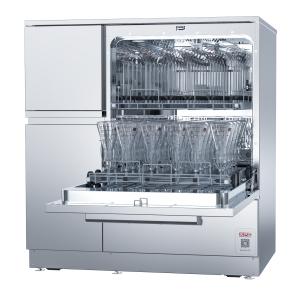In the pursuit of scientific research accuracy and efficiency, the design of laboratory glassware washer is particularly important. It not only affects the work experience of laboratory staff, but also directly affects the cleanliness of the laboratory and the accuracy of experimental results.
The overall structure of the laboratory bottle washing machine is made of stainless steel. The outer shell is made of 304 stainless steel, and the inner cabin is made of more corrosion-resistant 316L stainless steel, ensuring the long-term durability of the machine. The all-metal button operation design allows the staff to operate normally even when wearing gloves and with wet hands. At the same time, this design also effectively saves energy. The streamlined appearance is not only beautiful and generous, but also demonstrates its high-quality craftsmanship.
In addition to the innovation in design, this glassware washer has also been fully upgraded in terms of function. It can clean laboratory utensils of various shapes and sizes made of glass, ceramic, metal, plastic, etc., including but not limited to culture dishes, slides, pipettes, chromatography bottles, test tubes, triangular flasks, conical flasks, beakers, flasks, measuring cylinders, volumetric flasks, vials, serum bottles, funnels, etc. After cleaning, these utensils can reach the standard cleanliness and have better repeatability, providing strong support for laboratory scientific research.
However, in order to give full play to the performance of this bottle washer, the environmental conditions of the laboratory are also crucial. First of all, there should be enough space around the bottle washer, and the distance from the wall should be no less than 0.5 meters, so as to facilitate the operation and future maintenance of the staff. Secondly, the laboratory should be installed with tap water, and the water pressure should be no less than 0.1MPA. If secondary pure water cleaning is required, a pure water source, such as a bucket of more than 50L, is required. In addition, the laboratory should also have a good external environment, away from strong electromagnetic fields and strong heat radiation sources, the internal environment should be kept clean, the indoor temperature should be controlled at 0-40℃, and the relative humidity of the air should be less than 70%.
When installing the bottle washer, you also need to pay attention to some details. For example, two water source interfaces need to be provided, one for tap water and one for pure water. At the same time, it is also necessary to ensure that there is a drain near the instrument, and the height of the drain should not be higher than 0.5 meters. The proper handling of these details will directly affect the normal operation and use effect of the bottle washer.
Post time: Jun-21-2024

